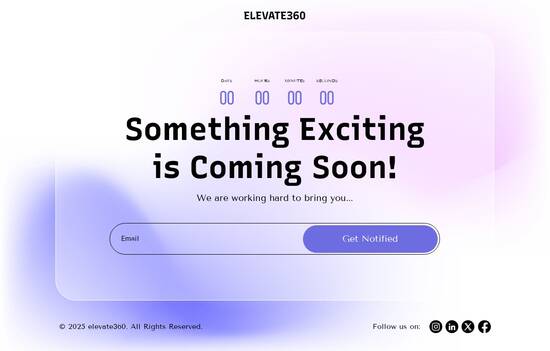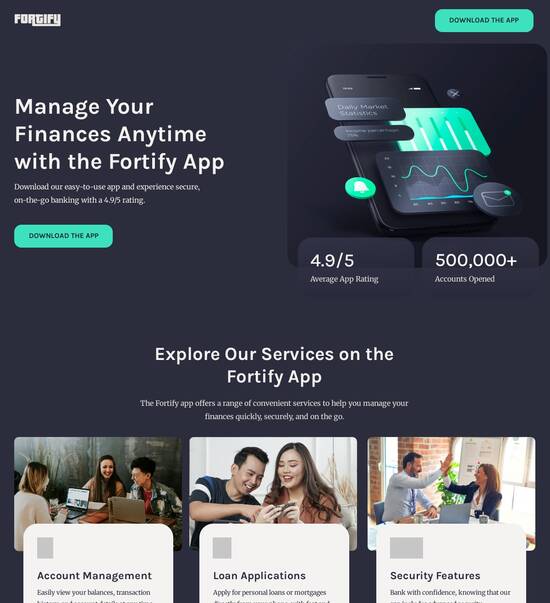
HTML page template for Clinical research coordinators
Use TemplateAbout template
Attract clients and showcase your skills with style using our landing page templates for Clinical research coordinators. Let's convert those visitors into clients!
Recommended templates

Easy to build without coding
With the intuitive drag-and-drop builder, anyone on your team can create high-converting pages without any knowledge of code or design. Make enhancements to your landing page with custom widgets using Javascript, HTML/CSS, or third-party scripts.

Multiple layouts for any industry and goal
Select from 500+ landing page layouts built to boost conversions across industry-specific scenarios. Customize them by adjusting fonts, adding images, and generating on-brand content with the AI assistant. Quickly scale with Instablocks® and Global Blocks that you can save, reuse, and update globally.

Loads fast and looks polished on any device
Every template is responsive, which means they present professionally on any device and load blazingly fast with our Thor Render Engine. You can also power them up with Google AMP technology to deliver an unparalleled mobile experience and drive higher conversions.

Robust analytics & experimentation
Get real-time updates and reporting across all your devices, showing the number of visitors, conversions, cost-per-visitor, and cost-per-lead. Launch AI-powered experiments, run A/B tests, and use heatmaps to analyze user behavior, then optimize your landing page to maximize conversions.







Easy to build without coding
With the intuitive drag-and-drop builder, anyone on your team can create high-converting pages without any knowledge of code or design. Make enhancements to your landing page with custom widgets using Javascript, HTML/CSS, or third-party scripts.
Multiple layouts for any industry and goal
Select from 500+ landing page layouts built to boost conversions across industry-specific scenarios. Customize them by adjusting fonts, adding images, and generating on-brand content with the AI assistant. Quickly scale with Instablocks® and Global Blocks that you can save, reuse, and update globally.
Loads fast and looks polished on any device
Every template is responsive, which means they present professionally on any device and load blazingly fast with our Thor Render Engine.
Robust analytics & experimentation
Get real-time updates and reporting across all your devices, showing the number of visitors, conversions, cost-per-visitor, and cost-per-lead. Launch AI-powered experiments, run A/B tests, and use heatmaps to analyze user behavior, then optimize your landing page to maximize conversions.
All the features you need to build lead-generating landing pages
Explore more featuresLearn how to build top-performing landing pages for any goal
FAQs
Leading the way in building high-performing landing pages





A comprehensive guide to utilizing Instapage for marketing success
Instapage is an all-in-one landing page and CRO platform that provides powerful capabilities to optimize your marketing campaigns. As marketers in diverse sectors such as business services, tech, and education strive to enhance their digital presence, understanding how to leverage Instapage can significantly boost ROI. This guide walks you through the essential steps to create stunning landing pages that convert effectively.
Getting started with Instapage
To maximize your campaigns with Instapage, start by logging into your account and exploring the dashboard. You will find access to over 100 conversion-focused templates that allow you to skip the design phase and focus on customization. Engage the intuitive editors to align your branding while maintaining high-quality visuals.
- Choose a template that fits your campaign objective. Each template is designed to cater to various business needs, ensuring relevance to your vertical.
- Customize your landing page with media elements such as images and videos to engage visitors effectively, enhancing user experience.
- Utilize lead generation components available within the templates to streamline your data collection process.
Optimizing for conversion
Once your landing page is live, the next step is optimization. Instapage's built-in experimentation tools make this process smooth. Get insights into user behavior through heatmaps, which reveal where visitors are clicking and spending the most time.
- Conduct A/B testing with different headlines, calls-to-action, or images to determine which elements resonate best with your audience.
- Track performance metrics using the analytics dashboard to inform your campaign strategy and improvements.
- Make data-driven decisions to iterate on your design, ensuring it aligns with audience expectations and behavior.
Personalizing your campaigns
Creating personalized experiences is crucial to capture unique audience segments. Instapage empowers you with dynamic text replacement features that adjust your messaging based on the user’s source. Additionally, AdMaps help connect specific ads to tailored landing pages.
- Deliver customized content for targeted ads to match user intent and increase relevancy.
- Utilize audience segmentation tools to tailor experiences that resonate with different demographics.
- Continuously track and analyze engagement at an audience level to fine-tune personalization strategies.
Effective collaboration is another key to fast-tracking your landing page success. Instapage's teamwork features enable you to collect feedback and make real-time adjustments securely, ensuring a unified approach to your campaigns.
In conclusion, by leveraging the capabilities of Instapage, marketers can create impactful landing pages that drive conversions and enhance customer engagement. Utilize these strategies to fully harness the power of this leading platform.
Get started with Instapage today, and transform your digital campaigns into success stories that maximize your ROI!
People also ask about HTML page template for Clinical research coordinators
HTML page template for clinical research coordinators
Understanding the role of clinical research coordinators in modern trials
Clinical research coordinators play a vital role in the oversight and management of clinical trials. Their responsibilities encompass a broad range of tasks including participant recruitment, data collection, regulatory compliance, and communication among various stakeholders. As the primary point of contact for participants, they ensure that trials are conducted according to protocols and regulatory standards. By facilitating smooth operations, coordinators directly influence the trial's overall success and integrity.
The importance of clinical research coordinators cannot be overstated in today’s clinical trial landscape. They not only help bridge the connection between researchers, participants, and regulatory bodies, but also serve to gather vital data that contributes to scientific advancement. Their role continues to evolve alongside advancements in technology and research methodologies, making them indispensable to contemporary clinical trials.
However, clinical research coordinators encounter numerous challenges in their roles. One of the main challenges is data management, where vast amounts of information must be accurately collected, stored, and retrieved. This complexity often leads to difficulties in ensuring data integrity and compliance with regulations. Additionally, participant engagement poses another challenge, particularly in maintaining motivation and understanding of trial protocols over extended periods.
Regulatory compliance is another significant hurdle, as clinical trials must adhere to stringent guidelines from authorities such as the FDA and NIH. Coordinators must be well-versed in evolving regulations to safeguard participant rights and ensure the ethical conduct of research. A strong understanding of these challenges allows clinical research coordinators to adopt strategies that enhance service delivery in clinical trials.
The need for a tailored HTML page template
Standard HTML templates often fall short when it comes to meeting the unique requirements of clinical research. Generally, these templates are designed for broader applications and may include generic data collection features that do not cater specifically to the needs of researchers and participants engaged in trials. This can result in missed opportunities for optimizing participant interaction and ensuring compliance.
Moreover, the absence of regulatory compliance tools in standard templates can lead to potential legal risks for research institutions. Tailored templates are crucial because they provide functionalities that are essential for maintaining compliance with required standards. By incorporating necessary tools, they ensure that all interactions and data gathered through the site support ethical research practices.
Creating user-friendly interfaces for participant interaction is also vital. A well-designed template can enhance participant recruitment by making the enrollment process straightforward and intuitive. By streamlining the dissemination of information about the trial, coordinators can foster better communication with potential participants, ensuring they have all the details needed to make informed decisions.
Essential features of HTML page templates for clinical research
Customizable layouts for diverse trial phases: Tailored HTML templates should accommodate pre-trial, trial, and post-trial stages. This adaptability allows for distinct layout variations based on specific phases, which can help in addressing unique requirements at each level.
Integrated data collection mechanisms: Secure online forms for participant questionnaires must comply with regulations such as HIPAA. This ensures safe handling of sensitive information while allowing for efficient data gathering.
Mobile responsiveness for participant accessibility: With many users accessing information via mobile devices, templates must be designed to be mobile-friendly. Techniques for ensuring cross-device compatibility are essential for making information readily available.
Information sections for comprehensive study overview: Key details regarding the study's purpose, eligibility criteria, and procedures should be clearly outlined. Including FAQs can also alleviate participant concerns, facilitating better engagement.
Graphs and visuals for enhanced data presentation: Utilizing infographics to represent trial outcomes improves the comprehensibility of complex data. Visual storytelling is an effective tool for aiding participants in interpreting data accurately.
Benefits of using HTML page templates for clinical research
Employing tailored HTML page templates brings a range of benefits that can significantly enhance trial management. Primarily, they promote efficiency by reducing the time coordinators spend on creating pages from scratch. This allows research teams to redirect their focus on more critical aspects of the trial, like participant care and data integrity, rather than technical details.
Another key benefit is improved participant engagement. Templates with interactive elements, such as video introductions and chat features, can result in increased motivation for participants to remain involved in the trial. Incorporating real-time communication tools, like chatbots, facilitates ongoing support for participants, ensuring their questions are answered promptly.
Regulatory compliance is paramount in clinical research. HTML templates can include built-in features that simplify compliance tracking, making it easier for coordinators to ensure adherence to protocols while maintaining organized storage solutions for essential documentation. Additionally, customized branding options can enhance credibility and help build trust between coordinators and participants.
Case studies: Real-world applications of HTML page templates
Consider Study A, where a clinical research team implemented custom HTML templates for participant recruitment. Prior to their introduction, the trial faced significant challenges in attracting participants. After adopting tailored templates designed for streamlined engagement, the study saw a 40% increase in recruitment rates within the first three months. By providing clear information and engaging visuals, the custom templates made the study more approachable for potential volunteers.
In another example, Study B, participant retention improved dramatically with enhanced communication efforts made possible through the use of dynamic HTML templates. By integrating FAQs, chat features, and regular updates via the study website, the research team managed to raise participant satisfaction rates by 30%. This showcases how effective communication, coupled with well-designed templates, can significantly impact participant experience and retention in clinical trials.
Implementing effective HTML page templates in workflow
The integration of HTML page templates in clinical research practices requires a structured approach. Begin the implementation process by thoroughly assessing the specific needs and objectives of the trial. Understanding the demographic of potential participants and the type of data needed is crucial to tailoring the template effectively.
After identifying these needs, the next step is the selection of the right template that aligns with the study's goals. This involves examining various options available and determining which features will best serve the study. Once a suitable template is chosen, customization becomes imperative for ensuring the template accommodates specific requirements of the trial.
Common challenges such as technical barriers or a lack of staff training may arise during implementation. To counteract these issues, proactive training sessions around template functionalities can be organized to ensure all team members are comfortable with the technology. This investment in training promotes confidence and can enhance the overall efficacy of the research efforts.
Future trends in HTML page templates for clinical research
As the landscape of clinical research continues to evolve, emerging technologies such as artificial intelligence (AI) and machine learning are set to influence HTML page template design. These advancements enable predictive analytics that can enhance participant experience by anticipating needs and behaviors, ultimately increasing enrollment and retention rates. Anticipating participant concerns and easing their trial journey will become increasingly viable.
Furthermore, innovations in data security will reinforce participant trust concerning their shared information. As the need for cybersecurity strengthens, advancements will focus on developing templates that can integrate secure data handling features seamlessly. This will be crucial in fostering a safe environment where participants feel confident participating in research efforts.
Evaluating the effectiveness of HTML page templates
To measure the success of HTML page templates in clinical research settings, determining key performance indicators (KPIs) is essential. These could include recruitment rates, participant retention metrics, and feedback scores from participants regarding their experience. Regular analysis of these indicators helps identify strengths and weaknesses in the templates used.
Utilizing analytics tools for ongoing evaluation is another effective strategy. Monitoring real-time data usage can provide insights on how participants are interacting with the content. This tracking enables coordinators to optimize the templates continuously, making necessary adjustments to enhance user experience and engagement over time.
Conclusion
The transformative potential of customized HTML templates for clinical research coordinators is clear. When tailored to meet specific study needs, these templates can greatly improve trial management and participant engagement. As new challenges arise and technology continues to advance, innovating with advanced HTML templates will empower clinical research coordinators to conduct trials more efficiently and effectively.
Engaging with clinical research coordinators: Feedback loops for continuous improvement
Gathering feedback from clinical research coordinators is crucial for continuously enhancing template designs. Surveys and interviews can be utilized to collect insights on how templates perform in real-world scenarios. Understanding their experiences allows for better alignment of template features with coordinators' needs.
Utilizing this feedback, the evolution of HTML page templates can be driven by community input. By fostering an interactive dialogue between developers and coordinators, enhancements can ensure templates remain relevant and beneficial, ultimately leading to improved participant experiences in clinical trials.
Ready to skyrocket conversions?
Supercharge your ad campaigns with high-performing landing pages
Get started














